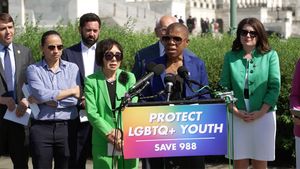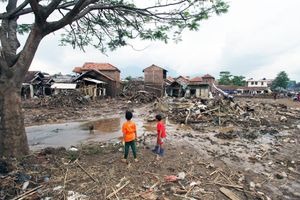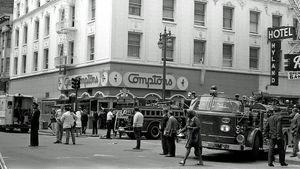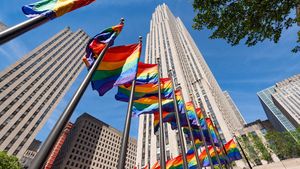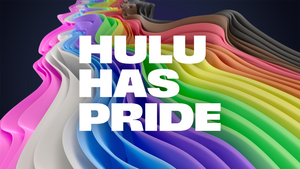Treatment GuideJust DiagnosedSex & DatingAfrican AmericanStigmaAsk the HIV DocPrEP En EspañolNewsVoicesPrint IssueVideoOut 100
CONTACTCAREER OPPORTUNITIESADVERTISE WITH USPRIVACY POLICYPRIVACY PREFERENCESTERMS OF USELEGAL NOTICE
© 2025 Pride Publishing Inc.
All Rights reserved
All Rights reserved
Scroll To Top
By continuing to use our site, you agree to our Privacy Policy and Terms of Use.
Jay Dagenhart pulls no punches when discussing how he contracted HIV. 'It was crystal,' the 38-year-old says of his five years of abusing methamphetamine, a highly addictive stimulant popular for its high-energy rush and enhancement of sexual activity. 'I went to bathhouses. I barebacked. I sold my body in my addiction. The reason I am HIV-positive today is because of what I did while high on crystal,' laments Dagenhart, who became a national face of the meth epidemic after discussing his experiences on The Oprah Winfrey Show in November 2005 and again in March of this year. But long before then, Dagenhart says, it bothered him that the facts behind how meth use was fueling HIV infections were treated as a dirty little secret that no one ever addressed. 'We weren't talking about it like we are now,' he says. 'We weren't talking about how people were seroconverting on this--like I did. We weren't talking about how people's lives were being taken over by this--like mine was. After I stopped using and got my life back on track, I felt like I needed to start some of those conversations.' Turning the Tables Getting harm-reduction messages back into the heads of drug users and warning nonusers of meth's dangers became Dagenhart's mission in life'and are the goals of crystal meth task forces that are forming in several U.S. cities. In November 2004, Dagenhart and Mike DiPilla founded the Philadelphia Crystal Meth Task Force, and Dagenhart served as its president until this past spring. Similar task forces have formed in major U.S. cities--including Atlanta; Chicago; New York City; Palm Springs, Calif.; Philadelphia; and Washington, D.C.--to help fight the rising use of the drug, particularly among gay and bisexual men. A key component of these groups' early efforts is addressing the links between meth use and HIV, including the adverse health effects the stimulant can have on HIVers, says Dan Carlson, cofounder of New York City's Crystal Meth Working Group. 'The more people binge,' he warns, 'the more they don't take care of themselves. They don't eat. They don't sleep. They don't do any of the things they need to do to stay healthy.' That includes failing to adhere to antiretroviral drug regimens, experts caution. HIVers must maintain nearly perfect drug adherence for their meds to remain effective. Missing even a few doses--which is easy to do during a meth-fueled weekend of sex and partying, Carlson says--can lead to treatment failure and the development of a drug-resistant infection. HIVers also may engage in unprotected sex--often with multiple partners they've met online or at bathhouses and sex clubs--while high on the drug, Dagenhart says, exposing others to the virus and putting themselves at risk for infection with multiple strains of HIV. If they've developed drug-resistant infections, they can pass those along to others as well. How Bad Is It? Studies have shown that meth use is becoming more commonplace--particularly among urban gay and bisexual men. In Chicago, 11% of gay men who were surveyed reported meth use within the prior year; one quarter of those who were surveyed in New York City used the drug during the prior six months. An informal survey of gay and bisexual men in Philadelphia that was conducted by the Philadelphia Crystal Meth Task Force revealed that about 20% of the men currently use meth, 40% had used it in the past, and 70% have friends who use the drug. More alarming still, some studies have provided data indicating that gay men who use meth are significantly more likely to engage in risky sexual behavior--and are as much as three times more likely to be HIV-positive than nonusers. 'Barebacking [having sex without a condom] was my agenda' while high on meth, Dagenhart says of why HIV rates are soaring among drug users. 'It's more erotic, more of an adrenaline rush. Meth pushes the idea of safer sex right out of your brain.' But despite these obvious risks, safer-sex messages either fail to resonate with meth users or are quickly forgotten during drug-fueled sexual encounters, says Dagenhart. 'Take me, for example,' he notes. 'I had all the information. I knew all of the reasons why I should be having safer sex. But while you're doing the drug, you just don't care.' DiPilla, who says he also contracted HIV through unprotected sex while using crystal meth, agrees: 'When I was high, you could talk about safer sex to my face and I would blow you off.' Working on the Problem Instead of just handing out condoms and urging people to practice safer sex, Dagenhart and other activists also are focusing on the root causes of meth abuse. For HIVers, they say, meth-induced feelings of well-being and acceptance can provide a temporary escape from the difficult realities of living with the disease. In addition to its libido-increasing effects, meth also can counter feelings of isolation, depression, shame, and low self-esteem that gay men may experience because of their sexual orientation. Crafting healthy solutions to these psychosocial problems could help allay the negative feelings that lead many men and HIVers to turn to the drug in the first place or to keep going back for more, community leaders say. 'We also have to come up with new models to teach gay men how to get involved with their communities and create new ways for them to be loving, healthy, responsible men, as opposed to the catty, vicious, self-hating people we too often see,' Dagenhart urges. 'And too many young gay men are still being mentored in gay communities on their knees or backs. This has to stop. There have to be better ways to 'be gay' than just drugs and sex.'
From our Sponsors
Most Popular
Lexi Love comes out as HIV+ after Trump deletes federal resources
January 23 2025 11:23 AM
Grindr is reminding us why jockstraps are so sexy and iconic
May 02 2025 5:36 PM
BREAKING NEWS: Trump admin moves to end federal HIV prevention programs
March 18 2025 6:10 PM
Trump's orders prompt CDC to erase HIV resources
January 31 2025 5:29 PM
Celebrating Black History Month with our annual African American issue
February 01 2025 3:28 PM
Tyler TerMeer vows to continue to fight for health care for all
January 28 2025 3:00 PM
Discover the power of Wellness in your life
March 26 2025 12:41 PM
Plus: Featured Video
Latest Stories
Dancer. Healer. Survivor. DéShaun Armbrister is all of the above
July 02 2025 8:23 PM
Two right-wing Supreme Court justices signal they may uphold access to PrEP and more
April 21 2025 4:10 PM
Broadway's best raise over $1 million for LGBTQ+ and HIV causes
April 03 2025 7:15 PM
Plus nominated for 2025 GLAAD Media Award
January 22 2025 12:42 PM
'RuPaul's Drag Race' star Trinity K Bonet quietly comes out trans
December 15 2024 6:27 PM
AIDS Memorial Quilt displayed at White House for the first time
December 02 2024 1:21 PM
BREAKING: Supreme Court rules to save free access to preventive care, including PrEP
June 27 2025 10:32 AM
1985: the year the AIDS crisis finally broke through the silence
June 26 2025 11:24 AM
Trump admin guts $258 million in funding for HIV vaccine research
June 03 2025 3:47 PM
500,000 Children at Risk: PEPFAR Funding Crisis
April 08 2025 3:51 PM
The Talk Season 5 premieres this spring with HIV guidance for the newly diagnosed
March 26 2025 1:00 PM
Jess King is here to help you live your happiest, healthiest life yet
March 24 2025 4:35 PM
A camp for HIV-positive kids is for sale. Here's why its founder is celebrating
January 02 2025 12:21 PM
VIDEO: A man living with HIV discusses his journey to fatherhood
June 10 2025 4:58 PM
HRC holds 'die-in' to protest Trump health care cuts
April 28 2025 2:11 PM
Season 4 of The Switch on resilience & radical self-love returns this spring
March 26 2025 12:20 PM
Gerald Garth is keeping people of color happy and healthy through trying times
March 11 2025 3:38 PM
This long-term HIV survivor says testosterone therapy helped save his life.
December 16 2024 8:00 PM
Ricky Martin delivers showstopping performance for 2024 World AIDS Day
December 05 2024 12:08 PM


































